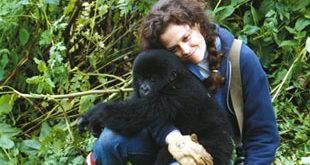
The unarmed unit, which has seized poison before it could be used and removed many bushmeat snares, is led on the ground by Samuel Bilério, a young veterinarian and trained ranger. “We are worrying about seeing poachers, as some have guns, but we have good morale,” Bilério says. “We are not here to fight, but to protect the lions and teach people.”
Lack of education and opportunities for local people is a key issue, he says, with little tourism in LNP to date: “If I was born in one of the villages here, I would be the poacher, I wouldn’t have a choice.” Tackling the conflict between villagers and the lions that sometimes kill their cattle is crucial, as the trade in lion parts now adds an extra incentive to retaliate. Cornélio Miguel, the warden of LNP, says: “In the villages, they know these animals as their enemy.”
Lion guardian schemes are being developed, aiming to build on successful schemes in Zimbabwe and Kenya where villagers are employed to keep cattle safe and chase off lions with blaring vuvuzelas. The devastation of lion prey by snaring for bushmeat to eat or sell is another big problem, despite it being outlawed in LNP.
One way this is being tackled is with 17 irrigation schemes to ensure food crops can survive droughts and that farmers can grow cash crops. Victor Sithole, who farms 110 cattle in the nearby village of Timhodzoene, says he has a problem with lions every few years, but adds: “The biggest issue is lack of water and grass.”
LNP is also relocating 2000 families from eight villages in LNP to outside the park. It’s a difficult choice, says Miguel: “Sometimes you have to make the right decision for conservation.” The park authorities welcome the help Everatt’s unit is giving to their anti-poaching efforts, which have stepped up in this year. “It is a fantastic concept,” says Peter Leitner, project director at LNP.
“It is showing a presence in areas we would not have got to.” LNP has also brought in expertise from the DAG Conservation Trust, set up by a former army colonel from Zimbabwe. There are 26 people in the team and two helicopters to chase poachers. “There have been a lot of contacts in the past two months,” says coordinator Sean van Niekerk. “They usually run. But if the guys have rhino horn, you are in for a fight.” A computer screen in their operations tent shows 12 poacher groups tracked across the park in September alone.
The lion poaching epidemic has also struck South Africa, but here captive lions – which outnumber wild lions – are the target. Tzaneen Lion and Predator Park, near Kruger, houses 60 lions and has been hit three times in three years, leaving nine lions dead and with their faces, paws and tails hacked off. “It is disgusting to see the animals cut up in front of you,” says park manager Jeanine vd Vyver.
“But if you are poor, it is a very good way to earn money in one go.” She thinks the criminals may earn 25,000 to 55,000 rand ($1,800-$3,900) per lion. Kelly Marnewick from the Endangered Wildlife Trust in Johannesburg says 71 captive lions have been poached in the last two years: “It certainly shows there is demand for this product.” That is a worry for captive and wild lions alike, say researchers. Andrew Loveridge, a Zimbabwean lion scientist from the University of Oxford, UK, says: “Incidents where lions have been specifically targeted by poachers are a huge concern.”
Research shows “an escalating trend in the trade of lion products is an increasing threat to some national populations”. Researchers are now trying to establish what is driving the demand, he says: “We do know that trophy hunters have been approached for access to lion carcasses (after skull and skin is removed), with up to $1,000 a carcass offered.”
In LNP, all those involved in conservation are optimistic that the annihilation of wildlife seen in past years can be turned around and that LNP has the potential to one day rival the incredible density of wildlife seen in Kruger, which is visited by 1.8 million tourists year. “LNP could be full of wildlife,” says Everatt. “We are increasing our presence on the ground, we are seeing more, chasing more and finding more,” says Miguel.
“With all our efforts we are moving to a better place – but poaching is still a challenge.” Back out in the bush by the Machampane river, Bilério remains on the trail of the ghost pride. They remain in deadly peril. With his team, he has been their protector for six months now and remains resolute. “I will see them,” he says. “They will not die before I see them.”
 The Independent Uganda: You get the Truth we Pay the Price
The Independent Uganda: You get the Truth we Pay the Price


